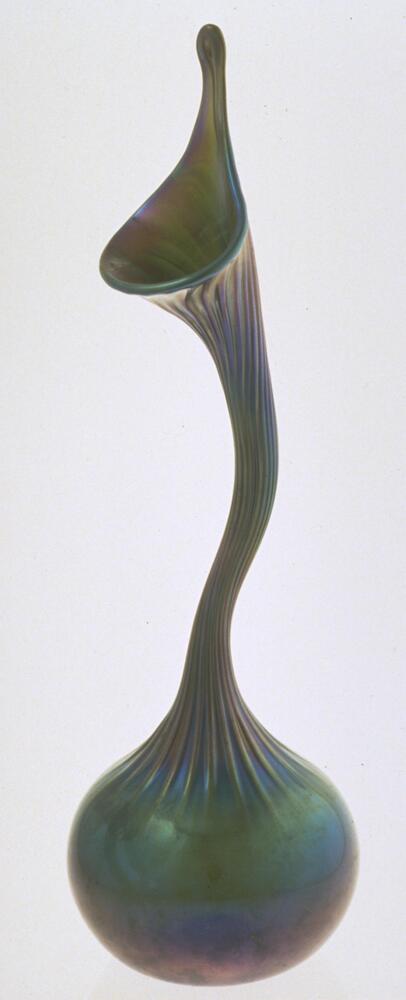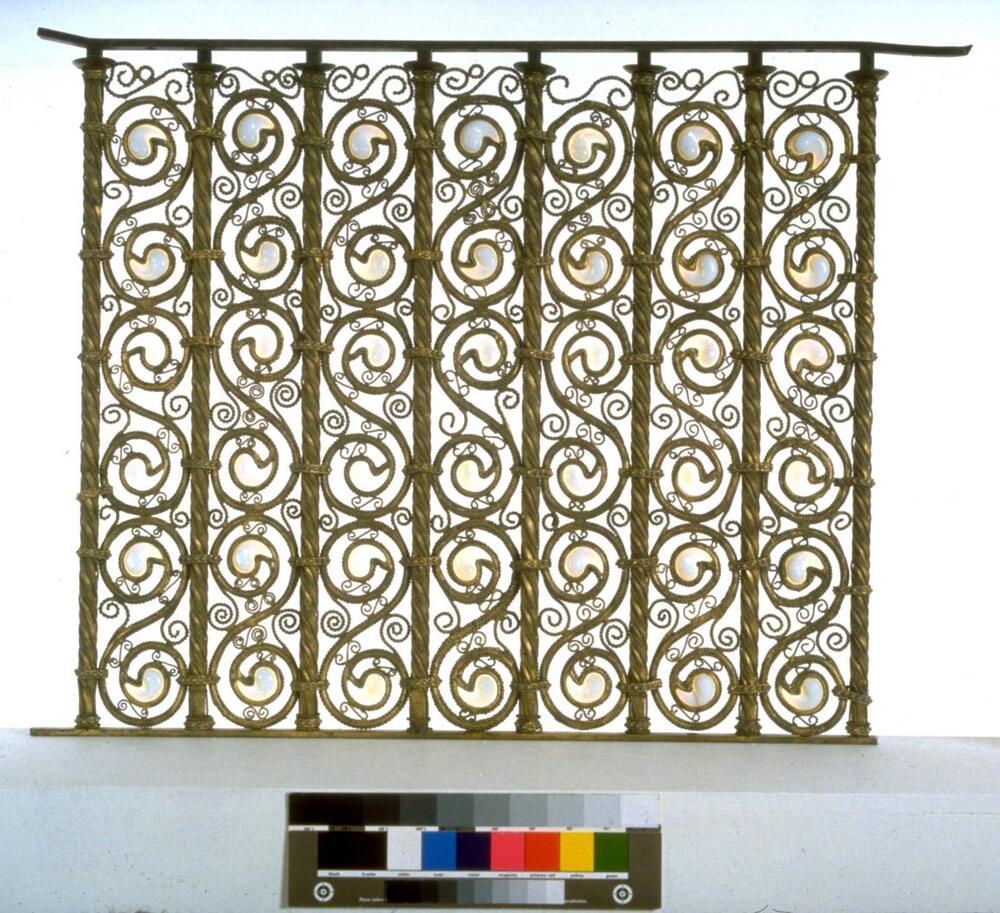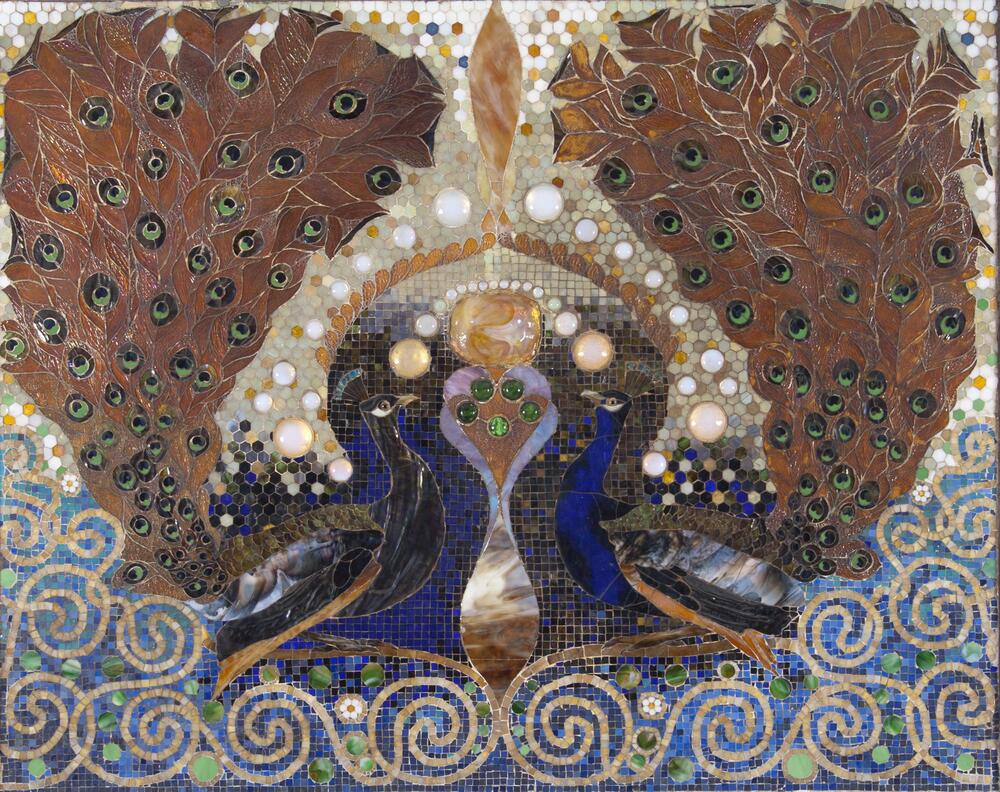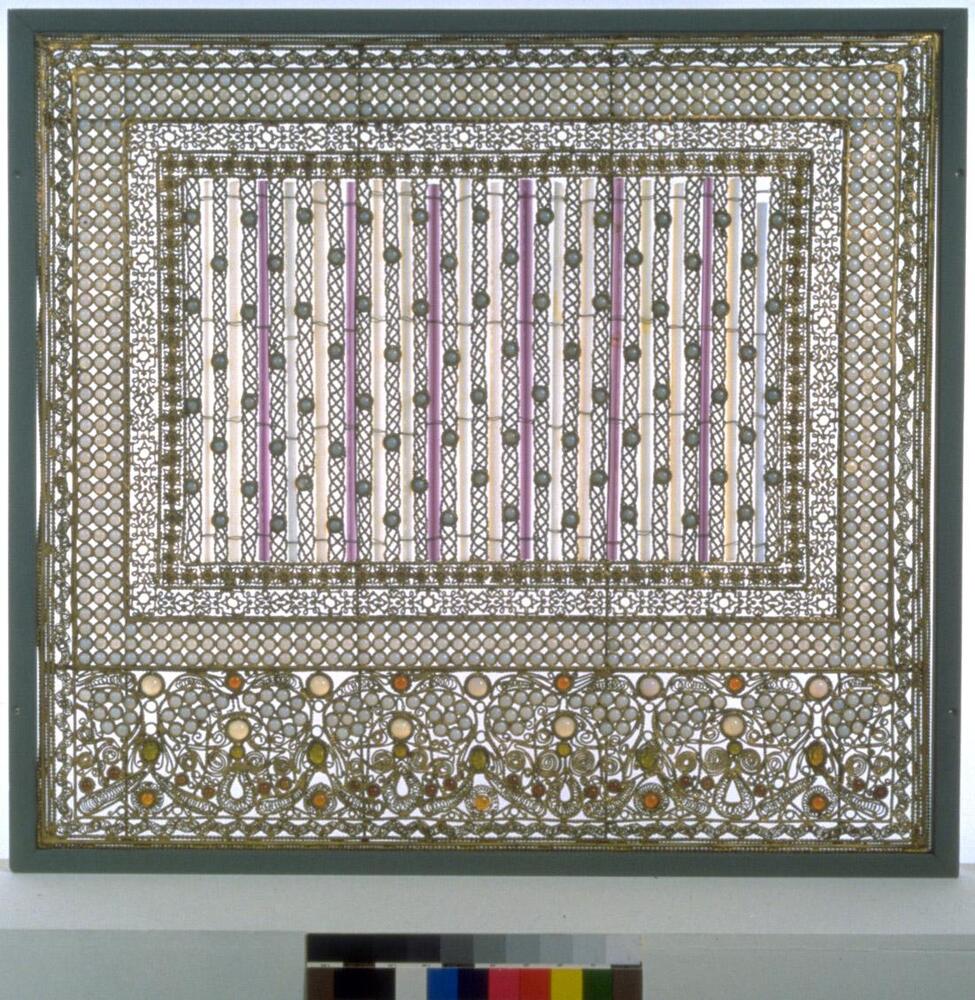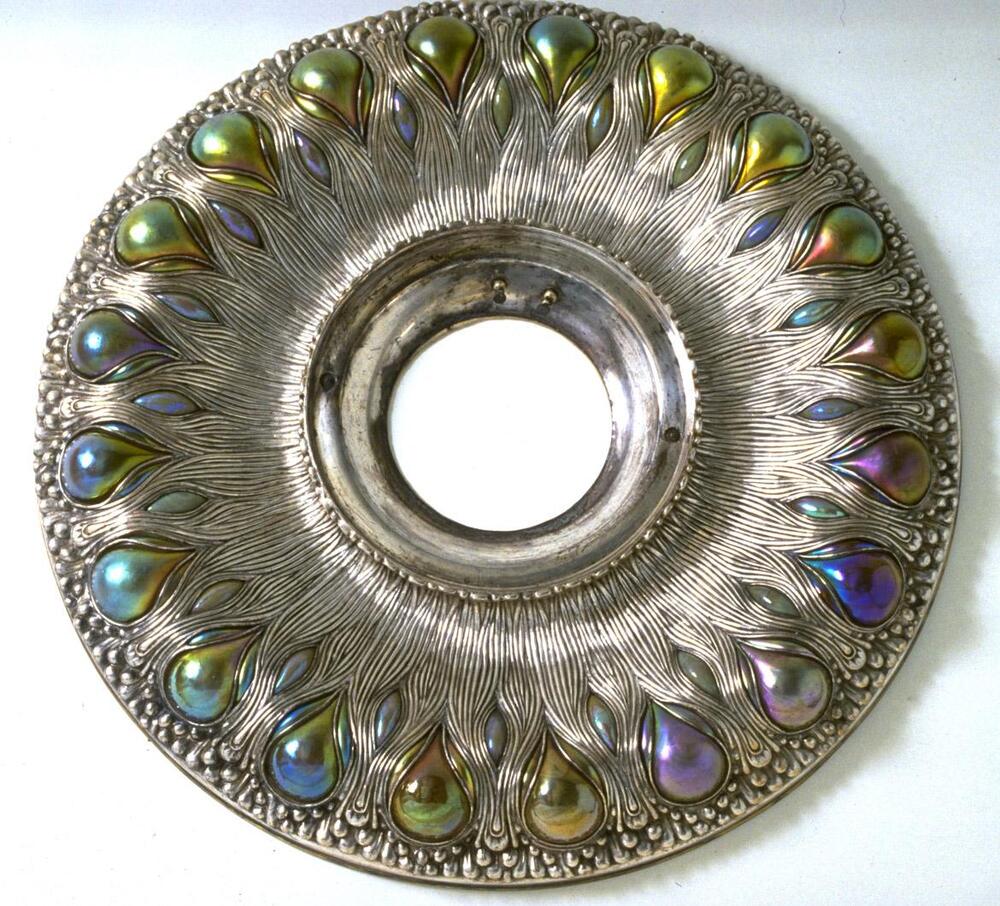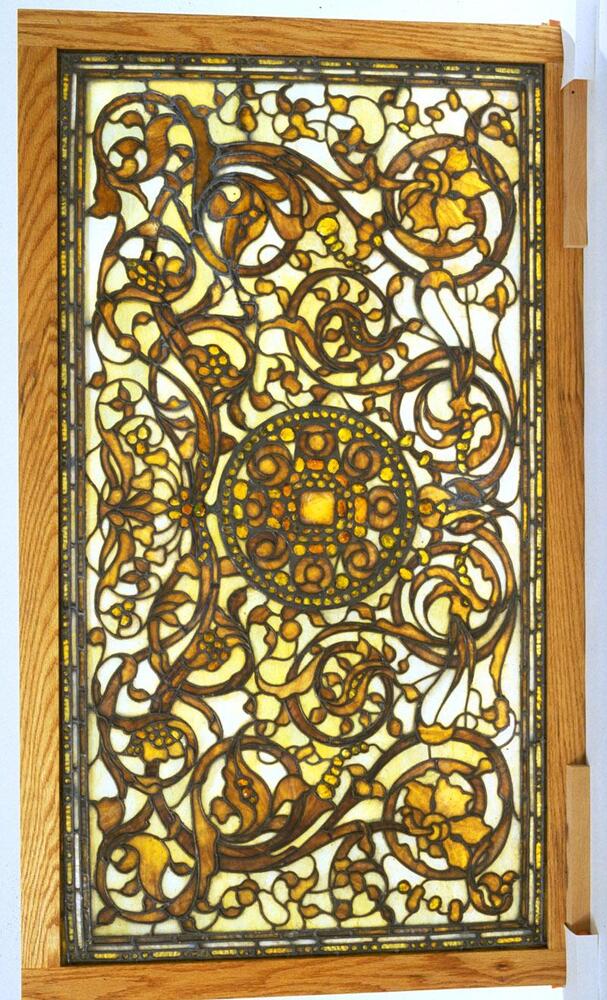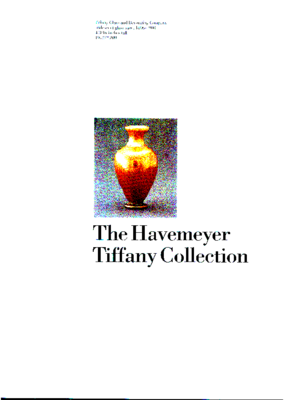The Havemeyer Tiffany Collection
Not surprisingly, Louis Tiffany enjoyed a privileged childhood. He attended a succession of private schools, including the Eagleswood Military Academy in New Jersey where he studied with the famous landscape painter George Inness. When he was seventeen Louis sailed for Europe. Upon his return to the States the following year he decided to become an artist. In the fall of 1866 Tiffany enrolled at the National Academy of Design in New York. Two years later he returned to Paris to enter the atelier of the academic artist Leon Bailly. While in Paris Tiffany met the painter Samuel Colman (1832-1920), with whom he would one day collaborate on the decoration of the Havemeyer House. Together the two artists travelled to North Africa. where they were greatly struck by the light, color, and pattern they encountered.
Tiffany worked largely as a painter during the 1870s, exhibiting at the National Academy, the Century Association, and elsewhere. But by the middle of the decade Louis had become friendly with Edward C. Moore, the leading silver designer for Tiffany and Company. It was Moore who encouraged the young artist to think about the expressive possibilities of the decorative arts and who introduced him to the influential Parisian dealer Samuel Bing.
In 1879 Tiffany formed his first company, Louis C. Tiffany and Associated Artists. His partners in this venture were Samuel Colman, Candace Wheeler, and Lockwood de Forest. Tiffany's many social connections quickly led to a series of important commissions from Cornelius Vanderbilt II, Ogden Goelet, and the White House, where Tiffany redecorated the state rooms for President Chester Arthur.
The firm was busy and successful, but in 1883 the increasingly divergent interests of the partners led to the friendly dissolution of the Associated Artists. Shortly afterward, with the help of architect Stanford White, Tiffany designed for himself and his family a large mansion at the corner of Madison Avenue and 72nd Street. For his own two-story studio/apartment at the top of the house Tiffany created an exotic and theatrical world of rich color, dramatic space, and evocative light. This extraordinary room, which one critic described as "like a bit from the palace of an Indian Rajah." had as its centerpiece a free standing, four-sided fireplace. Elsewhere in the room every imaginable type of sumptuous material and decorative style were combined and blended into a bold and original, yet unified, aesthetic whole. Tiffany's apartment quickly became the talk of New York, gaining him considerable fame and for a few commissions.In the same years Tiffany also directed a flourishing business providing stained glass windows for churches, civic buildings, and homes. A major exhibition for the 1893 Chicago World's Columbian Exposition further secured his American clientele and the active promotion of the firm's work in Europe by Samuel Bing gained Tiffany an international reputation. In 1891 Louis was issued a patent for his Favrile glass, a term deriving from the Old English word fabrile, meaning handmade. The widespread success of this richly colored and iridescent glass led to further expansion into pottery, metalwork, enamel, and particularly the lighting fixtures for which he is today so well known.
Tiffany's father died in 1902 and Louis became Vice President and Art Director of Tiffany and Company. In the same year he once again reorganized his own business under the name of Tiffany Studios and invested a portion of his inheritance in a new summer home on Long Island. Laurelton Hall became famous in subsequent years as the site of a number of lavish fétes and as the home of the Louis Comfort Tiffany Foundation, organized to aid young artists. By 1918 Tiffany had effectively retired from active participation in the affairs of his firm. He devoted his later years to painting and died in New York on January 17, 1933.
Henry O. Havemeyer (1847-1907) is today best remembered for the astonishing collection of nearly 2000 works of art bequeathed by his widow, Louisine Waldron Havemeyer (1855-1929), to the Metropolitan Museum of Art. This gift included magnificent old master pictures by El Greco, Goya, and Rembrandt and a particularly important group of nineteenth-century and Impressionist picture by Daumier, Courbet, Manet, Cassatt, Degas, Monet, and others. The collection also included prints and drawings, Asian Art, and Favrile glass by Louis Comfort Tiffany.Henry Havemeyer's grandfather emigrated from Germany to the United States in 1802. In subsequent years the family built up a large and prosperous sugar refining business centered in a huge factory on the Brooklyn waterfront. With greate determination and a natural flair for business, Henry took a lead in running the financial side of the family enterprises. By 1887 he had parlayed the refinery into the cornerstone of a vast trust which virtually controlled the processing of sugar in this country and generated enormous profits. In his own day Havemeyer was both respected and reviled as the "Sugar King."
In addition to his flair for business, Havemeyer had early on developed an interest in art and music. Around 1875 he made the acquaintance of the painter Samuel Colman and together they visited the Philadelphia Centennial Exhibition. It was Colman who encourage Havemeyer to start collecting and may very well have introduced him to Louis Comfort Tiffany.
Henry Havemeyer married Louisine Waldron Elder in 1883. This even signalled a major expansion in the family's collecting and patronage. Mrs. Havemeyer had lived in Paris where, in the company of her childhood friend Mary Cassatt, she developed a passionate interest in the work of her fellow expatriate, Whistler, and in the artists of the Impressionist circle.
By 1888 the Havemeyer collection had outgrown the family home on East 36th Street. To remedy this situation a site on the corner of Fifth Avenue and East 66th Street was acquired and the architect Charles Haight engaged. In contrast to the pretentious chateaux or palazzo built by other magnates, the facade of the large house at 1 East 66th Street was solid, sober, and understated.
The same could not be said for the interiors. From the start it was a foregone conclusion that the inside of the Havemeyers' new home would be designed by Tiffany and Colman. Not only were both individuals by this time close family friends, but Mrs. Havemeyer had also on a number of occasions visited Tiffany's lavish studio on 72nd Street. Fascinated, she was eager to have a similarly "artistic" interior for her own home. The Havermeyers soon numbered among Tiffany's most enthusiastic clients.Although the structure of the house was complete by the spring of 1890 , it took Tiffany and Colman an additional two years and over $250,000 to complete the interiors. The results were a virtuosic performance. Great leaps of imagination united every sort of color, pattern, and texture into a beautiful and effective setting for the Havemeyers' collection.
Entering from the street visitors passed through a remarkable set of doors into a sumptuous hall paved with over a million Hispano-Moresqure tiles. The wall were covered with mosaic panels and were surmounted by a mosaic frieze of palmettes. The centerpiece of the room was the fireplace, crowned by a great mosaic peacock and fronted by a gilt metal and opalescent glass firescreen fashioned to resemble a giant piece of jewelry. Samuel Bing aptly described the room as having "an air of gleaming opulence."
Author Aline Saarinen provides an evocative description of other rooms in the house:
...the Byzantine chapels of Ravenna inspired "our white mosaic hall and the ten pillars at the entrance of our gallery" ...the staircase derived from the one in the Doge's Palace ...the walls of the music room were covered with Chinese embroideries ... On the blue and gold Chinese rugs stood special, richly carved furniture rubbed with gold leaf and varnish to look like the ivory inro that inspired it. The furniture and the woodwork in the library [also called the "Rembrandt Room" after the eight works by that master which hung there] were based on Viking designs and Celtic motifs ...The library ceiling was a sensation ... a mosaic design of multicolor silks, outlined with heavy braid and framed with carved gold moldings...
<media one of 10 elements version="half" caption="yes" float="left">
The two-story upstairs gallery ... became a topic of ... conversation by virtue of its 'golden' or 'flying' staircase. A narrow balcony with an alcove ran around the second story of the picture gallery. The spectacular staircase was suspended, like a necklace, from one side of the balcony to the other. A curved piece of cast iron formed the spine to which, without intermediate supports, the stair treads were attached. The sides of this astonishing construction, as well as the balcony railings, were a spiderweb of gold filigree dotted with small crystal balls. The concept of a construction in space was revolutionary indeed for 1890 and its daring was dramatized by a crystal fringe on the center landing which tinkled from the slight motion when the staircase was used. (from Saarinen, pp. 155-7, and Weitzenhoffer, pp. 71 and 77).Samuel Bing captured the overall effect of the rooms:
...the ingenious eclecticism responsible for these interiors has so skillfully combined disparate elements,integrating them so artfully, that we ar eleft with an impression of perfect harmony ... a visitor is overcome, upon entering, with a subdued atmosphere of peace and quite. (Bing, 130)
The Havemeyers greatly enjoyed these rooms, entertaining in them regularly and proudly showing visitors from around the world their home and collection. A number of alterations were made over the years, including the addition of a foundation in the entrance hall and the building of a new gallery wing, but the house remained substantially as Tiffany designed it right up to Louisnine Havemeyer's death in 1929. Within a year of this event, however, the interiors were broken up and sold and the house itself demolished.
With the death of Louisine Havemeyer in January of 1929 her family carried out her wish that the most prized works in her collection be given to the Metropolitan Museum of Art. Other art works passed to family members or were sold at auction by the Anderson Galleries on April 10, 1930. The contents of the house on East 66th Street were similarly dispersed at auction on April 21-22, 1930.The Dean of the College of Architecture at the University of Michigan, Emil Lorch (1870-7963), was present at the Havemeyer sale. Over a period of years orch had acquired architectural fragments by Louis Sullivan, George Elmslie, G.B. Post, and others. The College collection eventually also included casts of architectural ornaments, a group of drawings and watercolors, Japanese prints and ceramics, and Cypriot antiquities. Using funds provided by newspaper magnate George Booth, Lorch was now able to acquire a particularly choice group of objects for the University. Altogether he purchased forty lots (nearly 400 pieces) at a cost of $2268. Included in this group was large assortment of pottery, enamels, tiles, glassware, wood carvings, metalwork, Egyptian glass, lacquer, and other decorative objects. Twenty-five lots (with a purchase price of $1325) were composed of Tiffany materials: interior elements from the Havemeyer house along with twenty-seven pieces of Favrile glass.
Dean Lorch's purchases at the Havemeyer sale were part of a major effort to assemble a teaching collection of artworks, cases, and architectural fragments. In selecting works for the collection, the Dean sough to illustrate for students a wide range of forms, colors, and textures. He was attracted by object of "exquisite workmanship" and "marked aesthetic appeal." Lorch believed strongly in the importance of learning "not through pictures but through intimate association with the originals." (Lorch, pp. 2-4)
The Havemeyer Tiffany collection was initally a source of pride for the University. After their acquisition a selection of works was displayed in special glass cases on the first floor of the architecture building, now Lorch Hall on Tappan Street. Later larger objects were installed in faculty offices around the building. Some were placed in storage. In the late 1930s, as Tiffany's work went out of fashion under the growing influence of modernism, more and more of the collection was consigned to closets or storerooms. Many pieces simply disappeared. The collection was further diminished in 1947 when a group of Tiffany objects was wold to New York dealer Victor Spark.In 1958 the tide began to turn when a group of smaller glass objects was transferred to the Museum of Art for safekeeping. In 1983 Museum Director Evan Maurer worked with School of Art Dean George Bayliss to transfer custody of the remaining works to the Museum. With the support of the National Endowment for the Arts a major conservation effort was then mounted to restore the collection to exhibitable condition. This five-year effort was largely complete by 1988. The Museum is proud to be able to return these masterpieces of American decorative art to public exhibition exactly one-hundred years after they were first installed in the Havemeyer House.
Part of 4 Learning Collections
<p>Exhibition: August 21, 2010 - November 28th, 201...
<p>Exhibition: October 10, 2009 - January 3, 2010</...
Created For
K-12 EducatorK-12 Student
Museum Visitor
UMMA Docent
UMMA Staff
University Faculty
University Student
Rate this Resource
AVG: 0 | Ratings: 0
& Author Notes
All Rights Reserved (William J. HennesseyDirector
The University of Michigan
Museum of Art)
Last Updated
April 19, 2017 4:46 p.m.Report
Reporting Policy

